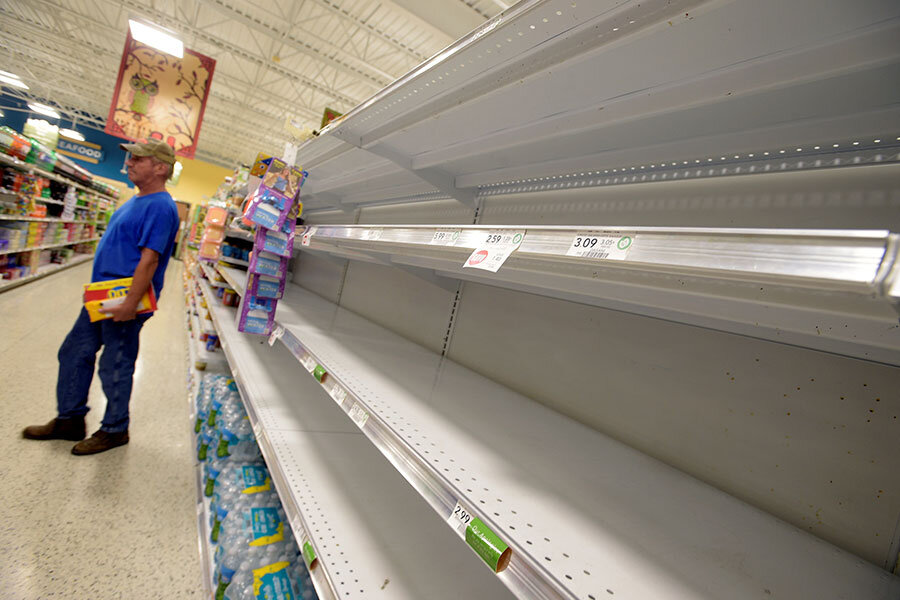What Matthew taught America about preparing for a hurricane
Loading...
| Boca Raton, Fla.
They stocked up on excessive amounts of food and bottled water. They waited in long lines for gasoline, only to discover many pumps already marked “empty” after early hoarders came with gaggles of jerry cans. They screwed in hurricane shutters and nailed up plywood over windows, making homes dark with anxious anticipation.
In many cases, they evacuated, especially after Florida Gov. Rick Scott told them in no uncertain terms, “This storm will kill you.”
The shocking words worked, because some two million people in Florida and the coastal areas of Georgia and the Carolinas evacuated their homes late last week in anticipation of hurricane Matthew. On Fox News, anchor Shep Smith went even further when showing the likely path of the hurricane.
“This moves 20 miles to the west, and you and everyone you know are dead — all of you — because you can’t survive it,” he said. “It’s not possible unless you’re very, very lucky. And your kids die, too.”
The fine balance between pointedly warning the public to prepare and dramatically predicting doom had been tipped. Then, Florida escaped the worst when Matthew “wobbled” east and didn’t make landfall until South Carolina.
Did everything happen as it should, with dire warnings calibrated to save lives? Or was there something a little too cataclysmic about both the warnings and way the media covered them?
“The caution struck me as appropriate, but it felt overhyped because we’re so surrounded by media,” says Suzanne Bring, who lives in Delray Beach, a short walk to the beachfront. “It’s the constant news feed coming to our phone, our computer, our TV, our iPad. That felt overwhelming to me, but that didn’t take away from the real, significant concerns.”
Just a block east of her apartment, on the other side of the intracoastal waterway that runs parallel to the Atlantic Ocean, thousands of residents were evacuated. But Ms. Bring and her husband decided to stay, putting up hurricane shutters and helping elderly people in her building do the same. Having been through many severe weather storms in her 25 years in Minnesota before moving here just over two years ago, the frenzy to snatch up food and bottled water – possibly fueled by images of people doing just that, and reports of stores running out – was baffling to her.
“There are weird, panicked reactions that we’ve seen over the course of this,” says Bring, a grant seeker in the health care industry.
Officials in Florida worry that newcomers who haven’t experienced a severe hurricane – the last one here was Wilma in 2005 – will now be less apt to respond with urgency the next time. Palm Beach County officials say the storm was clearly as dangerous as predicted, and they wouldn’t have done anything differently.
“We understand we were spared,” said Palm Beach County Administrator Verdenia Baker in a statement to the press Friday. “In the future, do not become complacent.”
Indeed, part of North Carolina is experiencing severe flooding, and there are estimates that Matthew will have done between $4 billion and $6 billion in damage. In Haiti, the death toll has topped 1,000.
The problem is that once the hurricane becomes “the” story, it gets covered nonstop even when there’s nothing new to stay, says Tsitsi Wakhisi, a journalism professor at the University of Miami’s School of Communications.
“When local news stations go to 24-hour coverage, they are filling up air space. So they repeat, repeat, repeat,” says Professor Wakhisi. “On one hand, I know they have to be repetitive because viewers come and go. But if you keep the TV on all day … then you can get scared and overreact.”
“When the reporters put on their yellow hooded rain coats and stand next to a swaying palm tree, time to switch channels. When the station airs the same press conference (“This storm is going to kill you”) more than three times in an hour, I switch channels or walk away from the set,” she says in interview via email.
Also, she notes, the coverage focused almost entirely on America about to be hit, and very sparsely on what had already been happening for days in Haiti.
“They focused on the storm that was coming, not the storm that already had done so much damage,” adds Wakhisi. “Both were important, especially given South Florida's proximity to Haiti and the large Haitian-American population here.”








